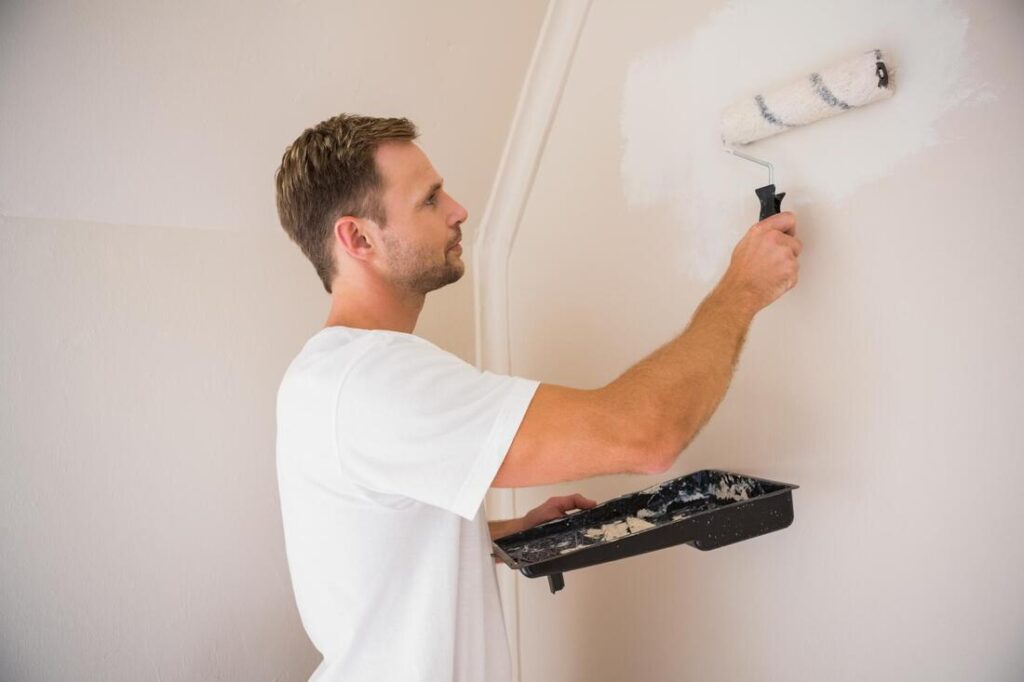The job of a painter is both an art and a skill. It needs a good grasp of different techniques and tools. Painters are key in changing spaces, in homes or businesses.
This article will look into the main painter duties and needs in Australia’s painting industry. We’ll cover the essential tasks, qualifications, job chances, and hurdles painters face. Our goal is to help future painters understand what it takes to succeed in this exciting field.
Overview of the Painting Profession
The painting profession is all about mixing creativity with technical skills. Painters do many things, like decorating homes and offices, and even making murals. This overview shows how versatile and skilled painters need to be in different settings.
Understanding the Role of a Painter
Being a painter is more than just painting walls. They prepare surfaces, match colours, and use special techniques for the perfect finish. They work on many projects, from homes to offices. Each job requires its own set of skills, leading to specialisation in certain painting areas.
Historical Context and Evolution of Painting
The history of painting is fascinating, showing how humans have expressed themselves over time. From ancient cave paintings to today’s modern techniques, painting has changed a lot. As technology advances, so do painting materials and methods, reflecting new artistic trends.
Core Duties of a Painter
A painter’s job includes many important tasks. First, they prepare the surface for painting. Then, they apply the paint using different techniques. Finally, they keep their tools in good condition for efficient work.
Preparation of Surfaces for Painting
Preparing the surface is key for a good paint job. This means cleaning, sanding, and priming. A clean surface helps the paint stick better.
Sanding makes the surface smooth. Priming adds a layer that helps the paint last longer. This step is crucial for a job that looks great for years.
Application of Paint and Other Finishing Techniques
After preparing the surface, it’s time to paint. Painters use brushes, sprayers, and rollers for different jobs. Brushwork is for details, sprayers for big areas, and rollers for walls and ceilings.
Finishing touches like glazing and varnishing make the paint job look even better. These steps add to the paint’s beauty and durability.
Maintaining Tools and Equipment
Keeping painting tools in good shape is vital. Clean and store brushes, rollers, and sprayers well. This way, they last longer and work better.
Tools in good condition help avoid mistakes in the paint job. Regular care means painters can do their best work. This ensures top-quality results.
Skills and Qualifications Required
To be a successful painter, you need to have certain skills and qualifications. These skills improve your work and make sure you follow industry rules. Knowing what skills are important can help you get ready for a career in painting.
Essential Skills for Aspiring Painters
Attention to detail is key for quality work and matching colours right. Knowing about colour theory makes your painting look better. You also need to be physically strong for long hours and precise with your tools.
Being able to communicate well is important too. It helps you understand what clients want and work with other tradespeople.
Educational Requirements and Training Options
To become a painter, you usually need formal training or an apprenticeship. There are many painting and decorating courses in Australia. These teach you the basics, safety rules, and the best ways to paint.
Short courses can also help you learn more about painting houses or businesses. They’re great for improving your skills.
Certification and Licensing in Australia
In Australia, getting certified as a painter is important for the law. It shows you know about safety. Many places require painters to have a license for big jobs or business work. This keeps everyone safe and avoids legal problems.
| Qualification Type | Description | Duration |
|---|---|---|
| Apprenticeship | On-the-job training combined with classroom instruction | 3-4 years |
| Vocational Training | Structured courses covering all aspects of painting | 6-12 months |
| Short Courses | Focused training on specific techniques or tools | Varies (1 day to several weeks) |
| Certification | Formal recognition of skills and knowledge in the painting trade | Variable (depends on the course) |
Job Opportunities for Painters
Australia offers a wide range of painting jobs. Painters can choose between residential and commercial painting. Each has its own challenges and pay. Knowing the difference helps match skills with the right job.
Types of Employment: Residential vs Commercial Painting
Residential painting focuses on homes and domestic areas. It includes both inside and outside painting. Painters here often work closely with homeowners and can get regular work.
Commercial painting deals with bigger projects like office buildings and retail spaces. It requires specific skills and safety knowledge. While pay can be higher, work hours can be unpredictable.
Freelance vs. Full-time Positions
Painters often decide between freelance and full-time jobs. Freelancing lets you choose projects and set your own hours. It offers flexibility and can lead to more money if you manage many clients.
Full-time jobs, however, offer stability and regular pay. They often come with benefits like health insurance. Painters in these roles can focus on specific techniques and enjoy a steady income.
The work of a painter: Challenges and Rewards
Starting a career as a painter comes with both challenges and rewards. You’ll face obstacles and enjoy the good parts of your job. It’s a field full of experiences, but it also needs hard work and commitment.
Common Challenges Faced by Painters
Painters often deal with tough weather, which can slow down outdoor work. They also face physical challenges, like working on ladders for long hours. Getting the finish just right can be stressful too.
Managing what clients want can be hard because beauty is in the eye of the beholder.
The Rewarding Aspects of Being a Painter
Despite the tough parts, painting has many benefits. Painters love making spaces look better and seeing clients happy with their work. They can also work for themselves, which gives them more freedom.
Every project is different, from small homes to big buildings. Seeing a job done well brings a lot of joy.
| Challenges for Painters | Rewards of Painting Profession |
|---|---|
| Adverse weather conditions | Transformation of spaces |
| Physical strain | Potential for self-employment |
| Need for precision | Diverse range of projects |
| Client expectations management | Creative satisfaction |
Health and Safety Considerations
The painting job comes with many hazards that can harm workers’ health. It’s key to know and follow safety rules for painters. This not only keeps workers safe but also meets Australia’s legal standards.
Importance of Safety Gear and Precautions
Wearing the right safety gear is crucial for painters. It includes things like respirators, gloves, and goggles. These protect against harmful chemicals and particles.
Learning how to use and care for this gear is important. It helps prevent injuries and health problems from toxic substances.
Regulations Governing Painting Practices
In Australia, painting work must follow strict rules. These rules are part of the Work Health and Safety (WHS) laws. They ensure safe work practices and handling of materials.
Material Safety Data Sheets (MSDS) are also important. They give details on dangerous substances and how to stay safe. Following these rules shows a commitment to safety in the workplace.
| Safety Gear | Purpose | Compliance Aspect |
|---|---|---|
| Respirators | Protect against inhaling hazardous dust and vapours | Required under WHS regulations |
| Gloves | Shield skin from chemicals and irritants | Recommended for handling paints and solvents |
| Goggles | Protect eyes from paint splashes and harmful substances | Mandatory for certain tasks as per safety standards |
| Coveralls | Prevent skin contact with hazardous materials | Encouraged as part of personal protective equipment (PPE) |
Conclusion
The painting profession has changed a lot over time. It now includes many tasks, from preparing surfaces to applying finishes. Knowing these tasks gives a clear picture of what a painter does.
The demand for painters is growing. This is because more people need skilled painters who can work efficiently and creatively. This makes the future of painters look bright.
To succeed in painting, you need the right skills and training. Getting an education and certification can really help. There are many jobs available in both homes and businesses.
Being a painter is not just a job; it’s a career that values creativity and skill. It’s a field that is always changing, with new techniques and materials being developed.
In short, painters play a big role in making our surroundings beautiful. With the industry’s constant evolution, it’s an exciting time to start a career in painting.


